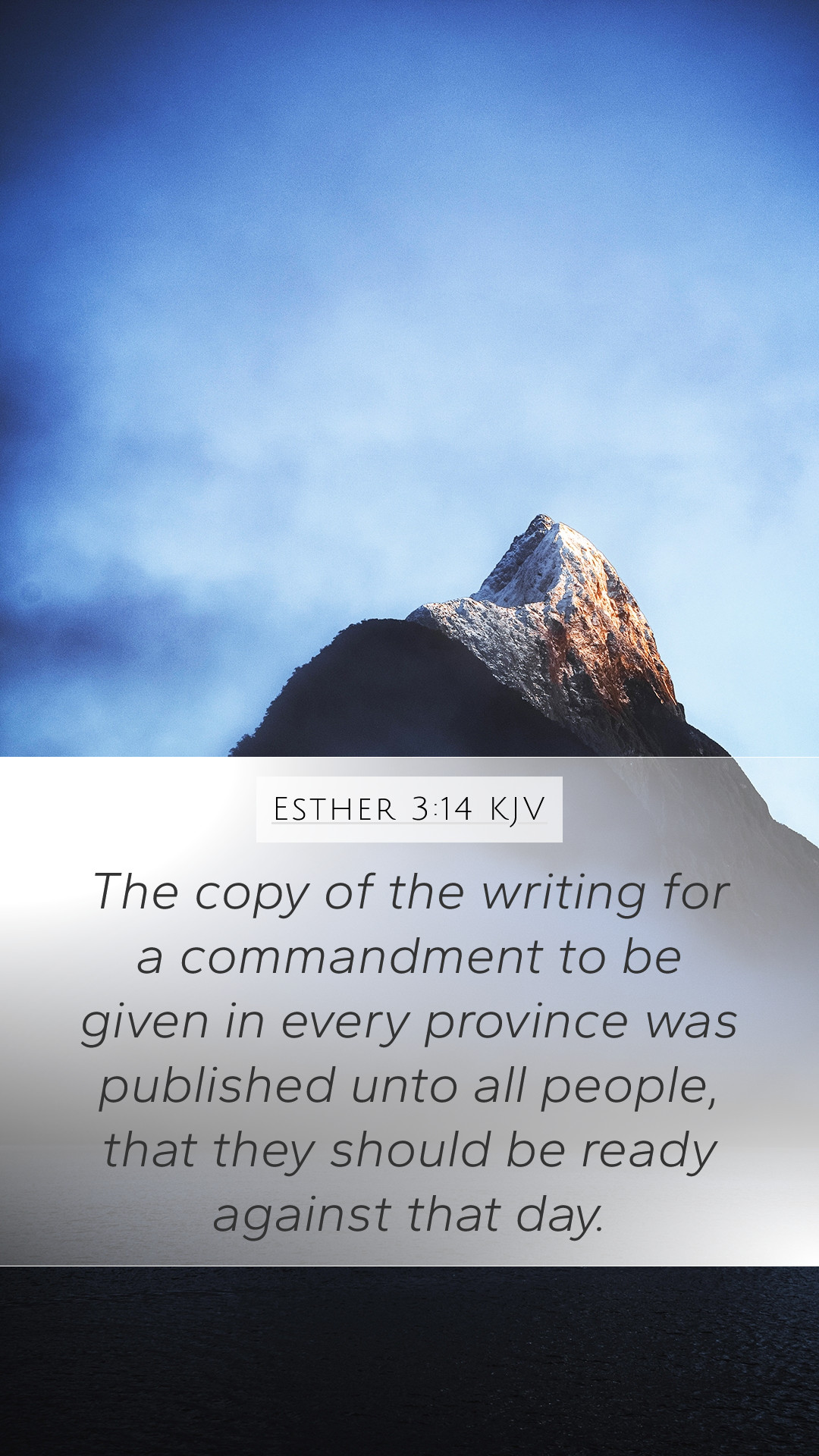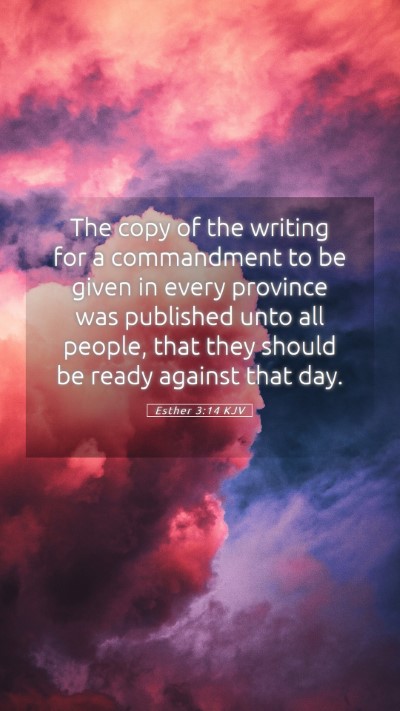Old Testament
Genesis Exodus Leviticus Numbers Deuteronomy Joshua Judges Ruth 1 Samuel 2 Samuel 1 Kings 2 Kings 1 Chronicles 2 Chronicles Ezra Nehemiah Esther Job Psalms Proverbs Ecclesiastes Song of Solomon Isaiah Jeremiah Lamentations Ezekiel Daniel Hosea Joel Amos Obadiah Jonah Micah Nahum Habakkuk Zephaniah Haggai Zechariah MalachiEsther 3:14 Meaning
What is the meaning of Esther 3:14?
The copy of the writing for a commandment to be given in every province was published unto all people, that they should be ready against that day.
Esther 3:14 Bible Verse Meaning
Bible Verse Meaning of Esther 3:14
The verse Esther 3:14 states: “The copy of the writing for a commandment to be given in every province was published unto all people, that they should be ready against that day.” This passage comes at a crucial point in the narrative of Esther, revealing the edict that would lead to the persecution of the Jewish people.
Overview of Esther 3:14
This verse underscores the gravity of King Xerxes’ decree, which was initiated by Haman. It highlights the preparation for impending danger faced by the Jewish people and the vastness of the decree, aiming to incite fear and urgency among individuals across the provinces.
Commentary Insights
-
Matthew Henry's Commentary:
Henry emphasizes that this decree symbolizes the rise of enmity against God’s people. The meticulous detailing of the command shows the methodical and oppressive nature of Haman's plan, designed to annihilate the Jews. The proclamation serves as a reminder of God’s providence amidst despair and paves the way for Esther’s courageous intervention.
-
Adam Clarke's Commentary:
Clarke elaborates on the intent behind the decree, showcasing Haman's wicked character and his influence over the king. This command is not merely a document; it is a representation of the chaos and suffering about to unfold. Clarke notes the significance of public awareness, which is critical for community response and preparation in the face of adversity.
-
Albert Barnes' Commentary:
Barnes points out the historical context of the edict's publication. It spread fear and panic among the Jewish people, compelling them to prepare for possible conflict. He draws attention to the importance of understanding this as a crucial moment in Jewish history, highlighting themes of survival and divine intervention that would unfold later in the narrative.
Theological Implications
Esther 3:14 can be interpreted as a profound metaphor for the battle between good and evil, illustrating the persistent danger that believers face. The verse speaks to the broader themes of hope, deliverance, and the sovereignty of God over human plots.
Contextual Analysis
Understanding the historical and cultural context of Esther 3:14 is vital for grasping its full meaning. The Persian Empire was marked by vastness and diversity, with local governance that ensured the king's decrees were efficiently communicated. This was the era of absolute monarchy, and the king’s word was law, adding gravity to Haman's actions.
Practical Application
In light of Esther 3:14, believers are encouraged to reflect on their responses to crisis situations. The public nature of Haman's decree invites individuals to consider how they can prepare spiritually and emotionally when faced with spiritual warfare or personal trials. It prompts discussions in bible study groups and online bible study settings about faith, preparation, and God’s providence.
Relevant Cross References
- Exodus 17:14 – God's instructions to Moses regarding remembrance of His deeds.
- Esther 4:14 – Mordecai’s challenge to Esther regarding her role in the salvation of the Jews.
- Psalms 124:2-3 – Acknowledgment of the peril faced by the people and God’s deliverance.
Conclusion
Esther 3:14 serves not only as a historical account but also as a source of deep theological insight, encouraging believers to understand the serious implications of oppression and the call to action in faith. The reflected commentaries help enrich our bible verse understandings and elucidate the significance of courage and divine providence illustrated in this critical moment in Jewish history.


